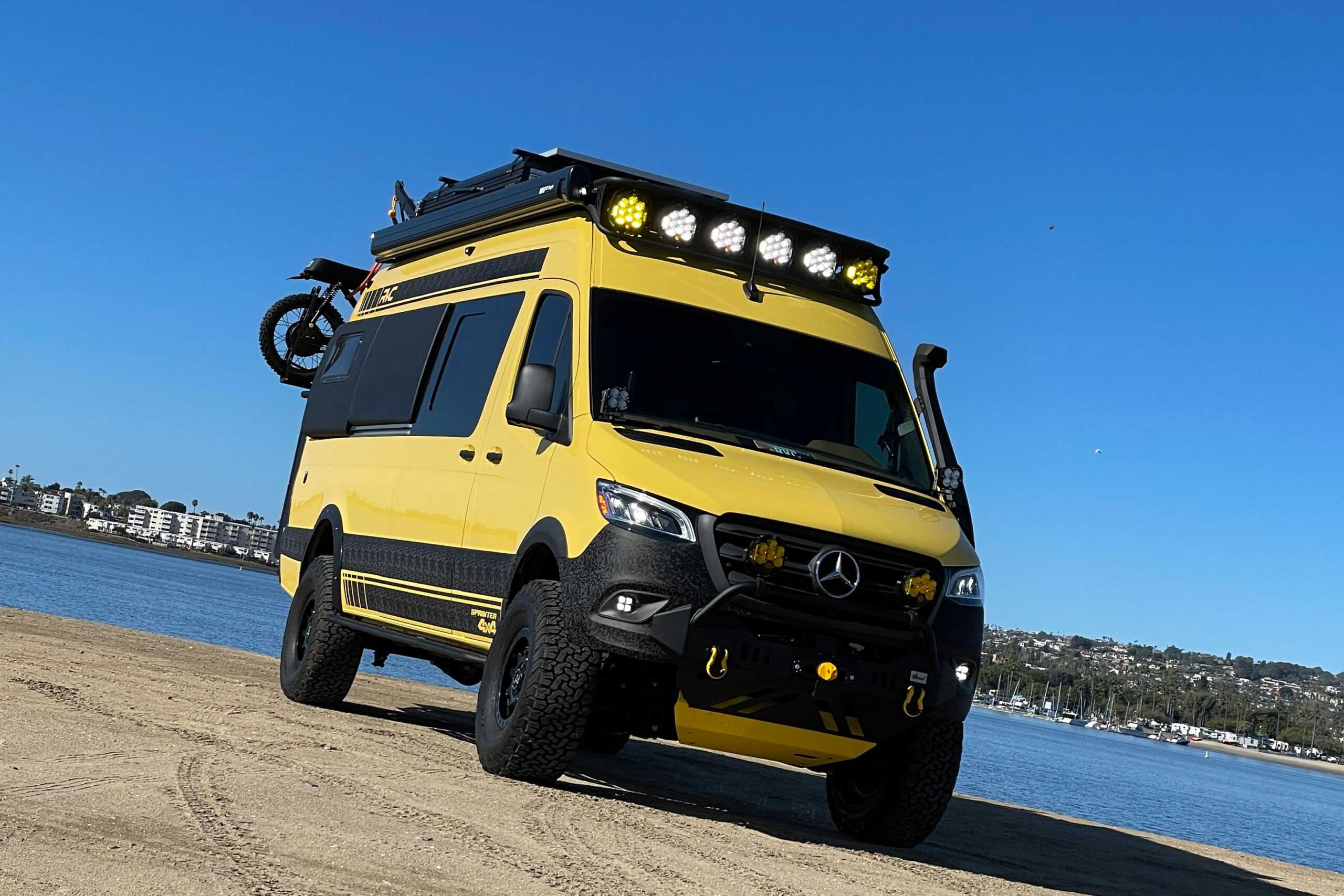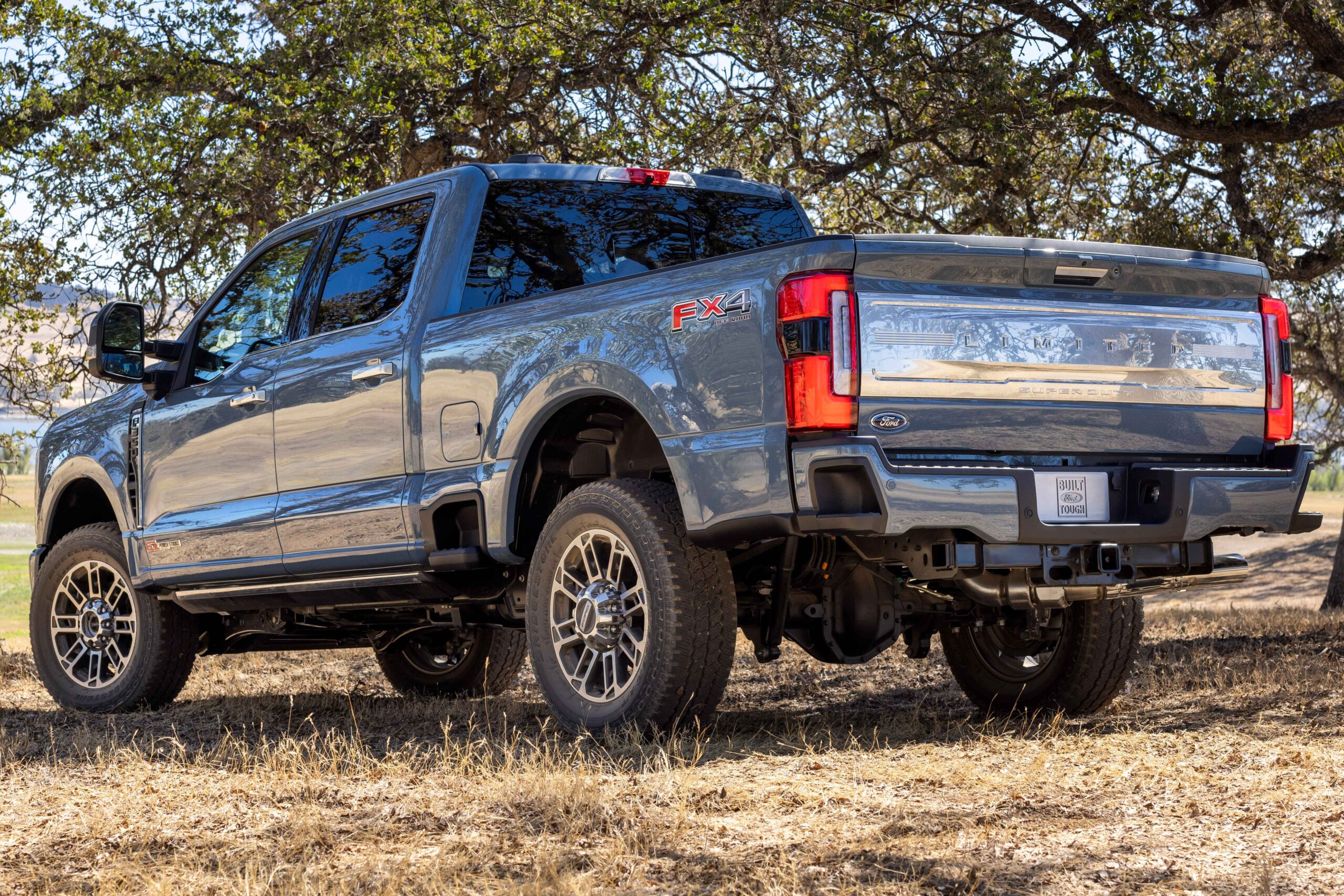Some ask why. The glass is half-empty, the outlook sarcastic, pessimistic. Others ask why not. The glass is half-full, the outlook sincere, optimistic. When it comes to building vans, Rogue Van Company (RVC) has a why not attitude. Why not exploit the cavernous Mercedes-Benz Sprinter van canvass’s full potential and bring to life all van fantasies by building the biggest and baddest behemoth possible?
The result is this 170-inch-wheelbase 2022 Mercedes-Benz Sprinter 4×4 adventure van concept named RC-1, one of the most monstrous, most yellow-ist vans we’ve ever seen—not to mention, arguably the most expensive we’ve come across. Sure, it’s completely unrealistic for most of mere humanity and utterly aspirational for normal people, but that’s what makes it an over-the-top why not project. It escalates and snowballs, slowly unlocking a full spectrum of parts, products, and mods that a van could have, should a van seem fit to have it all. It was a SEMA build, after all.
Ironically, at the end of the day, RVC fondly looks at its RC-1 creation and confesses that there are still things outstanding on the proverbial to-do list. Perhaps the deepest discovery unearthed by this project is that there is no finish line when it comes to building high-end luxury adventure vans. The end-game is the pursuit of more. These fully-prepped adventure rigs, in sharp contrast to the predictable pedestrian people-movers they started life as, are beholden to a bar that keeps raising—and seriously, we’re not mad about it one bit.
Built For Eyeballs
Let’s be clear. Rogue didn’t build the RC-1 to keep it in hiding—as if you could possibly hide something so huge and yellow. It’s probably visible from space. It barely fits in the Rogue headquarters bay door, its nose peeking out the front confirming that you’ve indeed landed at one of the two Rogue locations in San Diego, California. It’s unapologetically huge. There’s no denying that it’s a conversation-starter, the life of the party. You know LMFAO’s song “Sexy and I Know It?” Yeah, this van is down to party.
The RC-1 embraces its ostentatious demeanor by warmly welcoming curious visitors with a glass of chilled wine from the wine fridge or some whiskey on-the-rocks from the liquor bar built into the Flarespace Mega Flare (or some fine espresso from the portable Breville machine), both elegantly built-in to the absolutely gorgeous interior that’s draped in leather and surrounded by cedar tongue and groove walls. Like any good show vehicle begging for eyeballs, the van’s sexy electrical systems and associated plumbing and wiring are visible through plexiglass.
It’s easy to imagine Rogue employees nestled in the RC-1, inviting others to enjoy their creation with them. Intimidating as the van may be, the team behind the build is inviting, down-to-earth, non-judgmental of “ordinary” van builds. From bumper installs to full Mercedes-Benz Sprinter van conversions, Rogue Van Company takes on van modifications, add-ons, repairs and diagnostics of all scopes, recognizing that the scope of this project exceeds them all. The company, established in 2018, not only has CNC, laser cutting, and water jetting machines, but has also invested in top-notch alignment machines and ADAS radar calibration tools.
Built To Explore
The 2023 Mercedes-Benz Sprinter 2500 4×4 RC-1 SEMA concept rig is a whole lotta van, nearly dwarfing its massive 37×12.50R17 BFGoodrich All-Terrain T/A KO2 tires wrapped around Black Rhino Venture beadlock wheels. RVC can run this combination down to about 6 psi in the sand. In order to fit the 37s, RVC had to remove a lot of material from the rear wheel arch and cap it with custom wheel arch flares. That’s enough rubber to confidently hit moderate off-road trails without fear of tire damage.
The RC-1 goes from big to bigger—and gains more clearance—courtesy of a Van Compass Stage 6.3 2-inch suspension kit with adjustable Falcon 3.3 front and rear shocks and lots more, adjustable front Falcon inverted rally struts, Van Compass Opti-Rate leaf springs, and a Hellwig sway bar. Underbody protection comes courtesy of Van Compass skid plates. The upgraded suspension combined with true beadlocks results in a ride that’s pretty dang good for such a behemoth.
Roof clearance, of course, remains an unavoidable issue, compounded by the Rugged Design Concepts Baja LP9 roof rack and the newest addition, an Overland Vehicle Systems Mamba clam shell rooftop tent—for those brave enough to venture where only birds fly.
To atone for its excessive weight—about 10,000 pounds, but who’s keeping track—the diesel RC-1 sports a bolt-on rearend upgrade that’s new to the Sprinter van scene. Sourced from Owl Vans, the $10,000 replacement is called the Owl Rockkrusher Axle Upgrade (with E-Locker). The kit is compatible with all stock Mercedes sensors and mounts, and includes a robust list of goodness: thicker-walled 3.5-inch axle tubes (versus 3-inch), chromoly 35-spline axle shafts, beefed-up Currie Dana 60 with an Eaton E-Locker, 9.75-inch ring gear, and a 4.10 gear ratio. Stop drooling; All you can see from this big-deal upgrade is the beefy blue forged differential cover.
It’s hard to spot all the off-road goodies clinging to the schoolbus-yellow paint, so we’ll point some out: Rugged Design Concepts rock slider steps; Rugged Design Concepts rear bumper (with sensor relocation brackets); S&B Filters snorkel; Owl Vans spare tire carrier, bike carrier, and Monster Box; CATuned Off-Road Hammerhead front bumper with a Warn winch; and the world’s biggest array of exterior lighting from Baja Designs. As for the inside, there’s a Garmin navigator and PRP off-road storage bags.
As for recover gear? Yeah, there’s a bunch: Deadman Off-Road Recovery Stretchy Band, shackles, and more; Snap-On tool cabinet with a bounty of fine tools; and recovery boards. Essential for any van build, Rogue did not skimp when it came to such gear for its RC-1.
Because electric bikes and adventure vans go together like peanut butter and jelly, an Onyx Motorbikes RCR 72V Dirt e-moto bike rides up high on the back of the RC-1. How does it get there? With a wireless 12-volt hoist custom created by RVC. We tried to get Rogue to give us a hoist en lieu of using any of the various ladders, but we all got distracted petting the shop dog instead. It’s reassuring to know that the RC-1 doesn’t take itself too seriously. At the end of the day, vans should be about having fun and building community.
Built For The Elements
The RC-1 is no half-done hunk of faux components. All of systems work and are serviceable. We ran out of coffee learning about its complex power systems, but here are the basics. It’s powered by four BigBattery 48V Mustang lithium ion phosphate batteries (139Ah/7kWh) stuffed under the floor. Doing the math, that equates to 28 Kwh of 48V DC lithium power. Victron Energy and Blue Sea Systems safely control the flow of electrons, as monitored and displayed by the Victron GX Touch 70 touchscreen. For adding juice to the batteries, there’s an EV vehicle charging port, 30-amp shore power port, Custom Marine Products semi-rigid walk-on solar panels good for 1,200 watts, and a 48V auxiliary 4.8kw alternator.
A 48-volt floor-mounted Cruise N Comfort Mini Split System air conditioner keeps partiers comfortable, as does the Aqua-Hot Gen1 diesel heater/hot water heater (that’s hooked to the extended-range 47-gallon S&B Filters fuel cell). Rogue Van’s radiant flooring system efficiently mates to the Aqua-Hot system for optimal heat output throughout the cabin. Insulation comes courtesy of Havelock Wool sustainable sheep’s wool insulation. There’s a 37-gallon fresh water tank in the factory spare tire location and an additional 29-gallon flush-mounted tank created by Rogue Van Company.
Built For An Elevated Experience
The RC-1 counters its rowdy, brawny appearance with a stunningly handsome interior that’ll make you want to spend way too much time inside. The countertops, Lagun table, and upper cabinet faces are constructed of rich black walnut (harvested from RVC CEO Santiago Fileta’s home-away-from-home in the Ozarks) mixed with a deep epoxy for a look that’s seriously lovable. The cabinets themselves are constructed from an attractive veneer mounted on Baltic birch. All the kitchen ware, including the Half Face Blades special edition camp chef knives set, have dedicated custom-molded inserts so they don’t bang around. If you’re able to find it, a tablet screen is recessed into the wall behind the sink’s drop-down table.
While we’re easily wooed by the sauna function that fills the wet bath with relaxing steam, RVC points out the milled Corian base by Custom Shower Bases, a feature you just don’t find in vans. A Laveo Dry Flush portable electric toilet stows and seals contents in a bag—kind of like a sophisticated Diaper Genie, for those with littles in diapers. The Flarespace flares allow for a horizonal Queen-sized bed that features a six-inch natural latex mattress custom made by Mattress Makers to fit the exact dimensions of the RC-1’s sleeping area.
Built To Empty The Pocketbook
Now, for the part we’ve all been waiting for—the mortgage-sized price tag for RVC’s most insane van build to date. Rogue has the van listed on its website for $750,000. After contemplating that kind of money, financing a Rogue van build that starts at $180,000 (Sprinter van included) sounds downright reasonable. Cheers to Rogue Van Company for knocking our socks off with the RC-1, a why not adventure van that’s helping revolutionize the high-end expedition-style van market.



























